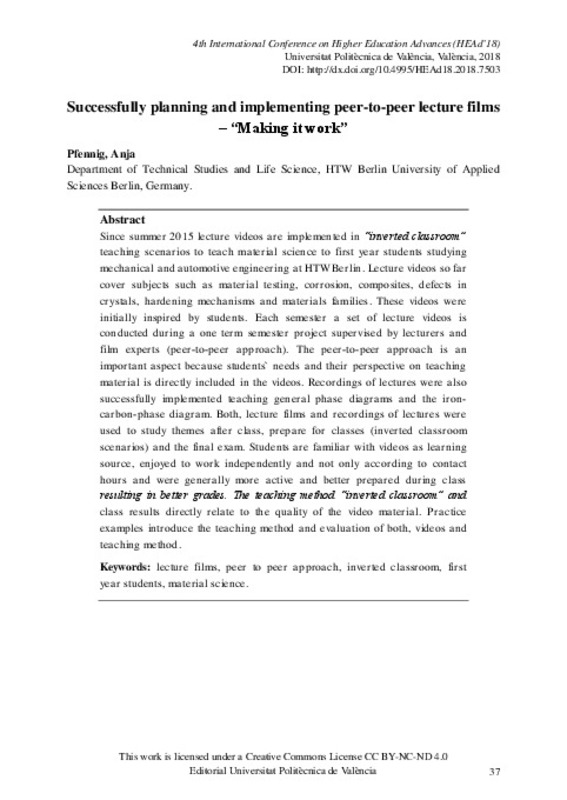JavaScript is disabled for your browser. Some features of this site may not work without it.
Buscar en RiuNet
Listar
Mi cuenta
Estadísticas
Ayuda RiuNet
Admin. UPV
Successfully planning and implementing peer-to-peer lecture films – “Making it work”
Mostrar el registro sencillo del ítem
Ficheros en el ítem
| dc.contributor.author | Pfennig, Anja
|
es_ES |
| dc.date.accessioned | 2018-10-05T12:24:59Z | |
| dc.date.available | 2018-10-05T12:24:59Z | |
| dc.date.issued | 2018-07-02T12:24:59Z | |
| dc.identifier.isbn | 9788490486900 | es_ES |
| dc.identifier.issn | 2603-5871 | |
| dc.identifier.uri | http://hdl.handle.net/10251/109550 | |
| dc.description.abstract | [EN] Since summer 2015 lecture videos are implemented in “inverted classroom” teaching scenarios to teach material science to first year students studying mechanical and automotive engineering at HTW Berlin. Lecture videos so far cover subjects such as material testing, corrosion, composites, defects in crystals, hardening mechanisms and materials families. These videos were initially inspired by students. Each semester a set of lecture videos is conducted during a one term semester project supervised by lecturers and film experts (peer-to-peer approach). The peer-to-peer approach is an important aspect because students` needs and their perspective on teaching material is directly included in the videos. Recordings of lectures were also successfully implemented teaching general phase diagrams and the iron-carbon-phase diagram. Both, lecture films and recordings of lectures were used to study themes after class, prepare for classes (inverted classroom scenarios) and the final exam. Students are familiar with videos as learning source, enjoyed to work independently and not only according to contact hours and were generally more active and better prepared during class resulting in better grades. The teaching method “inverted classroom” and class results directly relate to the quality of the video material. Practice examples introduce the teaching method and evaluation of both, videos and teaching method. | es_ES |
| dc.description.uri | http://ocs.editorial.upv.es/index.php/HEAD/HEAD18 | es_ES |
| dc.format.extent | 8 | |
| dc.language | Inglés | es_ES |
| dc.publisher | Editorial Universitat Politècnica de València | es_ES |
| dc.relation.ispartof | 4th International Conference on Higher Education Advances (HEAD'18) | |
| dc.rights | Reconocimiento - No comercial - Sin obra derivada (by-nc-nd) | es_ES |
| dc.subject | Higher Education | es_ES |
| dc.subject | Learning | es_ES |
| dc.subject | Educational systems | es_ES |
| dc.subject | Teaching | es_ES |
| dc.subject | Lecture films | |
| dc.subject | Peer to peer approach | |
| dc.subject | Inverted classroom | |
| dc.subject | First year students | |
| dc.subject | Material science | |
| dc.title | Successfully planning and implementing peer-to-peer lecture films – “Making it work” | es_ES |
| dc.type | Comunicación en congreso | es_ES |
| dc.type | Capítulo de libro | es_ES |
| dc.identifier.doi | 10.4995/HEAD18.2018.7503 | es_ES |
| dc.rights.accessRights | Abierto | es_ES |
| dc.description.bibliographicCitation | Pfennig, A. (2018). Successfully planning and implementing peer-to-peer lecture films – “Making it work”. Editorial Universitat Politècnica de València. 37-44. https://doi.org/10.4995/HEAD18.2018.7503 | es_ES |
| dc.description.accrualMethod | OCS | es_ES |
| dc.relation.conferencename | Fourth International Conference on Higher Education Advances | es_ES |
| dc.relation.conferencedate | Junio 20-22,2018 | es_ES |
| dc.relation.conferenceplace | Valencia, Spain | es_ES |
| dc.relation.publisherversion | http://ocs.editorial.upv.es/index.php/HEAD/HEAD18/paper/view/7503 | es_ES |
| dc.description.upvformatpinicio | 37 | es_ES |
| dc.description.upvformatpfin | 44 | es_ES |
| dc.type.version | info:eu-repo/semantics/publishedVersion | es_ES |
| dc.relation.pasarela | OCS\7503 | es_ES |








